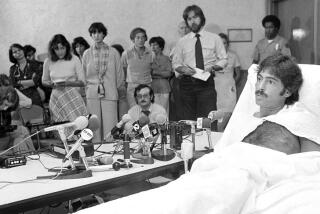Jonestown Did Little to Hinder New Movements : Formation of Cults Continues in ‘80s, Researcher Says
- Share via
A leading chronicler of religious movements in the United States says that the formation of what many call “cults” has continued unabated in the 1980s--despite the wary atmosphere created since the Jonestown mass murder-suicides 10 years ago this week.
Anti-cult groups, such as the Cult Awareness Network and American Family Foundation, have long insisted to parents, students, courts and news media that many offbeat religious groups use devious proselytizing and “brainwashing” methods to build quasi-spiritual hegemonies--charges called exaggerations by many religious experts.
Yet, “the anti-cult movement . . . has had no measurable effect (on) the development of nonconventional religions,” said J. Gordon Melton of Santa Barbara in a paper prepared for delivery Monday at the annual meeting of the American Academy of Religion in Chicago.
Summary of Book
Summarizing research he did for the third edition of his unparalleled “Encyclopedia of American Religions,” to be published next month, Melton said that 35 new groups took shape in the 1940s, 88 formed in the 1950s, 175 in the 1960s, 216 in the 1970s and 103 so far have been found with origins in this decade.
Although the 1980-1989 total is half that of the previous decade’s, Melton said there is often a 5-year delay between the beginnings of a religious group and when he learns of its existence. He said he expected to hear of “numerous additional groups” over the next several years.
His 2-volume encyclopedia was first published in 1978. Melton formed the Institute for the Study of American Religion as a writing and lecturing base. He now is a visiting scholar in the religious studies department at UC Santa Barbara.
Melton’s list of nascent religious groups encompasses a wide range--from magic, psychic and metaphysical organizations to relatively traditional Hindu and Buddhist bodies. But he contended that all are “nonconventional” within the prevailing Judeo-Christian culture and “almost all of the groups have been labeled ‘cult’ ” by antagonists.
“Nonconventional religion in the United States has flourished for a generation,” he said, “and is transforming America religiously into a radically pluralistic culture.”
Melton took issue with some common scholarly theories about the growth and trials of new religious movements. Contrary to popular assumptions, he said, most nonconventional religions do not fall apart when a charismatic founder dies, nor are they otherwise short-lived phenomena.
“Of more than 500 groups formed since 1950, less than 100 have become defunct, and 21 of those were small Neo-Pagan covens and groves which have been quickly replaced,” he said.
Neo-Pagan groups, a form of popular magical religion, “seems to have a bright future in spite of forces in the culture that continue to identify it falsely with Satanism,” said Melton, who holds a doctorate from Garrett Theological Seminary.
Melton also disputed the theory that tied the campus and war-protest turmoil of the late 1960s to the emergence of spiritual movements in the 1970s. He said that theory “found particularly fertile soil” in studies associated with the Center for the Study of New Religions at Berkeley, which has defended the legitimacy of the movements.
Melton said the continued formation of new religious groups in relatively stable and conservative times seems to belie that theory.
More to Read
Sign up for Essential California
The most important California stories and recommendations in your inbox every morning.
You may occasionally receive promotional content from the Los Angeles Times.










